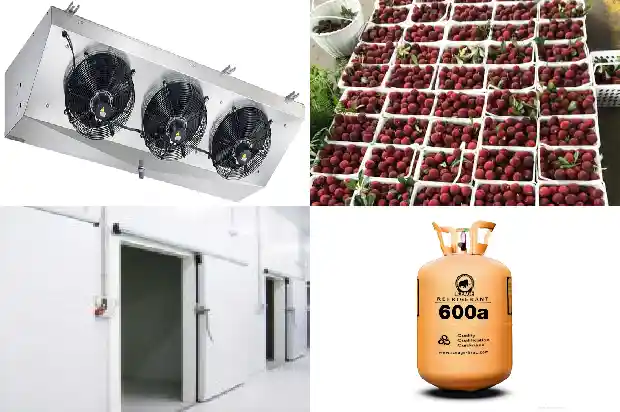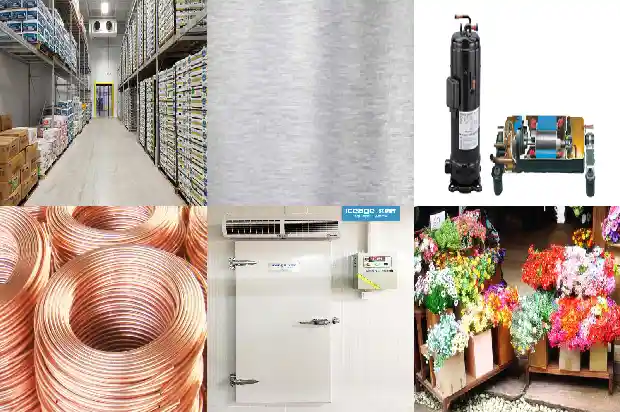Several Methods of Defrosting in Cold Storage
2025-03-11
Defrosting of the cold storage is mainly due to the excessive frost formation on the surface of the evaporator in the cold storage, which increases the thermal resistance of the evaporation pipeline and hinders the heat conduction of the pipeline, thus affecting the refrigeration effect. During the use process, the frost on the evaporator needs to be removed regularly, otherwise it is not conducive to the normal operation of the cold storage.
I. Analysis of the Reasons for Excessive Frost Formation in the Cold Storage
I. Analysis of the Reasons for Excessive Frost Formation in the Cold Storage
- Check the refrigerant and see if there are any bubbles in the sight glass. If there are bubbles, it indicates a shortage, and the refrigerant should be added from the low-pressure pipe.
- Check whether there are gaps in the cold storage panels near the frost-covered pipes, which may lead to cold loss. If there are gaps, seal them directly with silicone sealant or foam agent.
- Check whether there are leaks at the pipeline welding joints. Spray a leak detection liquid or soapy water and see if there are any bubbles.
- Whether the low-pressure is lower than the normal value, whether there is a blockage in the circulation of the system, or whether the outer surface of the evaporator is too dirty.
II. Selection of the Defrosting Scheme for the Cold Storage
Sometimes, several different defrosting schemes need to be combined for defrosting the cold storage. For example, for the pipes on the shelves, walls, and tops of the cold storage, the combination method of manual operation and hot gas (heat pump) can be adopted. Usually, manual frost removal is carried out, and hot gas defrosting is carried out regularly to thoroughly remove the parts that are not easily cleaned by manual frost removal, and the accumulated oil in the pipeline is flushed out with hot gas. For the air cooler, water flushing, heat pump, and electric heating methods are used for defrosting. For cold storages with a large amount of frost that require frequent defrosting, heat pump defrosting and water defrosting can be adopted. When the refrigeration system of the cold storage is working, the surface temperature of the evaporator is usually below zero degrees Celsius. Therefore, the thick frost formation on the evaporator will increase a large thermal resistance, so necessary defrosting treatment is required. The evaporators of the cold storage are divided into wall pipe type and fin type according to their structures. The wall pipe type is for natural convection heat transfer, and the fin type is for forced convection heat transfer. Generally, manual defrosting is used for the wall pipe type, and electric heating defrosting is used for the fin type. Manual defrosting is relatively troublesome. It requires manual frost removal and cleaning of the frost water, and also requires moving the items in the storage. The work (operation) intensity is high, and it takes a long time. For the electric heating type, electric heating pipes need to be inserted into the fin evaporator, and electric heating wires also need to be placed in the water receiving tray. The control method of the operation of the electric heating pipes generally adopts timed heating control. When heating, the electric heating pipes transfer heat to the evaporator, and the frost on the evaporation coil and fins melts when heated. Therefore, after the evaporator is fully covered with frost, the heat exchange coefficient is extremely low.
III. Several Defrosting Methods for the Cold Storage - Water Spraying Defrosting:
Water spraying defrosting is to spray the evaporator regularly with normal temperature water to melt the frost layer. The method of water spraying defrosting is relatively simple. For example, spraying the evaporator with brine with a concentration of 5% to 8% to prevent the formation of frost has a higher efficiency, a simple operation procedure, and a small fluctuation of the storage temperature. The disadvantage is that water defrosting is likely to cause fog in the storage and water dripping from the ceiling of the cold room. - Compressed Air Defrosting:
For the continuous freezing type food quick freezing device, defrosting during the operation of the system (such as using hot gas defrosting + water defrosting) will seriously affect the production capacity of the device, thus wasting production materials and increasing the production cost. The advent of the frost-free quick freezing device has solved the disadvantages of defrosting. This quick freezing device uses compressed air to spray the surface of the evaporator in a circular manner to remove the tiny frost on the surface of the evaporator at any time, keeping the surface of the evaporator always frost-free. This is a defrosting method for special production processes. Its advantage lies in ensuring the continuous operation of the refrigeration system. However, due to the need for compressed air, the defrosting process is also relatively power-consuming, and the high price of the device is also a major disadvantage. - Hot Gas (Heat Pump) Defrosting:
Directly introduce the high-pressure and high-temperature gas discharged after compression into the evaporator. When the storage temperature rises to 1°C or above, close the conversion valve. The temperature of the evaporator rises, prompting the frost layer on the surface to melt and fall off.
Hot gas defrosting is economical and reliable, convenient for maintenance and management, and the investment and construction difficulty are not great.
- Electric Heating Defrosting:
Defrosting by heating with an electric heater. Although it is simple and easy to implement, according to the actual structure of the cold storage and the actual use situation, the construction difficulty of installing the electric heating wire is not small, and the failure rate in the future is relatively high, the maintenance and management difficulty is relatively large, and the economy is poor. - Mechanical Defrosting:
The mechanical defrosting of the cold storage mainly uses tools for manual defrosting. If the cold storage is designed without an automatic defrosting device, when the frost layer on the evaporation coil of the cold storage needs to be removed, only manual defrosting can be carried out. The operation intensity is high, and there will be many inconveniences.
IV. Other Defrosting Methods for the Cold Storage - Ultrasonic Defrosting: This is a defrosting method with obvious energy conservation. The arrangement law of the ultrasonic generator should be further studied to improve the defrosting effect for engineering application.
- Liquid Refrigerant Defrosting: The refrigeration process and the defrosting process are carried out simultaneously, and there is no additional energy consumption during the defrosting period. The principle is to use the liquid refrigerant before the throttling of the subcooling expansion valve to improve the refrigeration efficiency and keep the storage temperature basically stable. The higher liquid temperature generated by the subcooling heat exchange is still within the normal temperature range.
The temperature rise of the evaporator during the defrosting period is small, and the fluctuation of the heat load of the evaporator is small. The disadvantage is that the system is complex and the control is cumbersome.
V. Defrosting Time
The defrosting cycle of the cold storage should be determined according to the time when the frost usually forms to a certain thickness on the evaporator, or based on the cumulative operating time of the compressor. Generally, defrosting is carried out once every about 4 to 6 hours. The defrosting time should not be set too long or too short. The electric heating defrosting generally takes 15 to 25 minutes. Try to carry out reasonable defrosting to improve and ensure the operation efficiency of the cold storage.
Related Articles
- Frosting in the Cold Storage? A Detailed Explanation of the 9 Reasons for Frosting of Air Coolers and 4 Defrosting Methods~~
- Why Does the Air Cooler Frost? What Are the Defrosting Methods?
- The Use and Common Maintenance Methods of Refrigeration Compressors
- Wiring Methods, Faults and Classifications of Fan Coil Units, All Here~~
- How Do You Remove Mildew from the Cold Storage? Have You Used These Methods?
- Common Faults in Refrigeration Systems and Handling Methods
- Cleaning Methods of Tubular Coolers
- Oil Cooling Methods and Oil - changing Operation Procedures for Screw Compressors
- Types of Refrigerants and Leak - detection Methods
- Introduction to Inspection and Handling Methods for Refrigerant Leak in Cold Storage
- Three Common Methods for Removing Water Scale from Water - cooled Condensers
- Reasons for Frost Formation in Cold Storage and Defrosting Methods
- Maintenance Methods for Small Modular Cold Storage Failures
- Cleaning Procedures and Methods for Cooling Towers and Heat Exchangers
- Common Cold - chain Storage Methods for Fruit and Vegetable Cold Storage
- Cleaning Methods for Different Types of Condensers in Refrigeration Devices
- Why Should Refrigerant Be Filled in Liquid Form? What Are the Filling Methods?
- For Computer Room Air Conditioners, Besides Air - cooled and Water - cooled, What Other Cooling Methods Are There?
